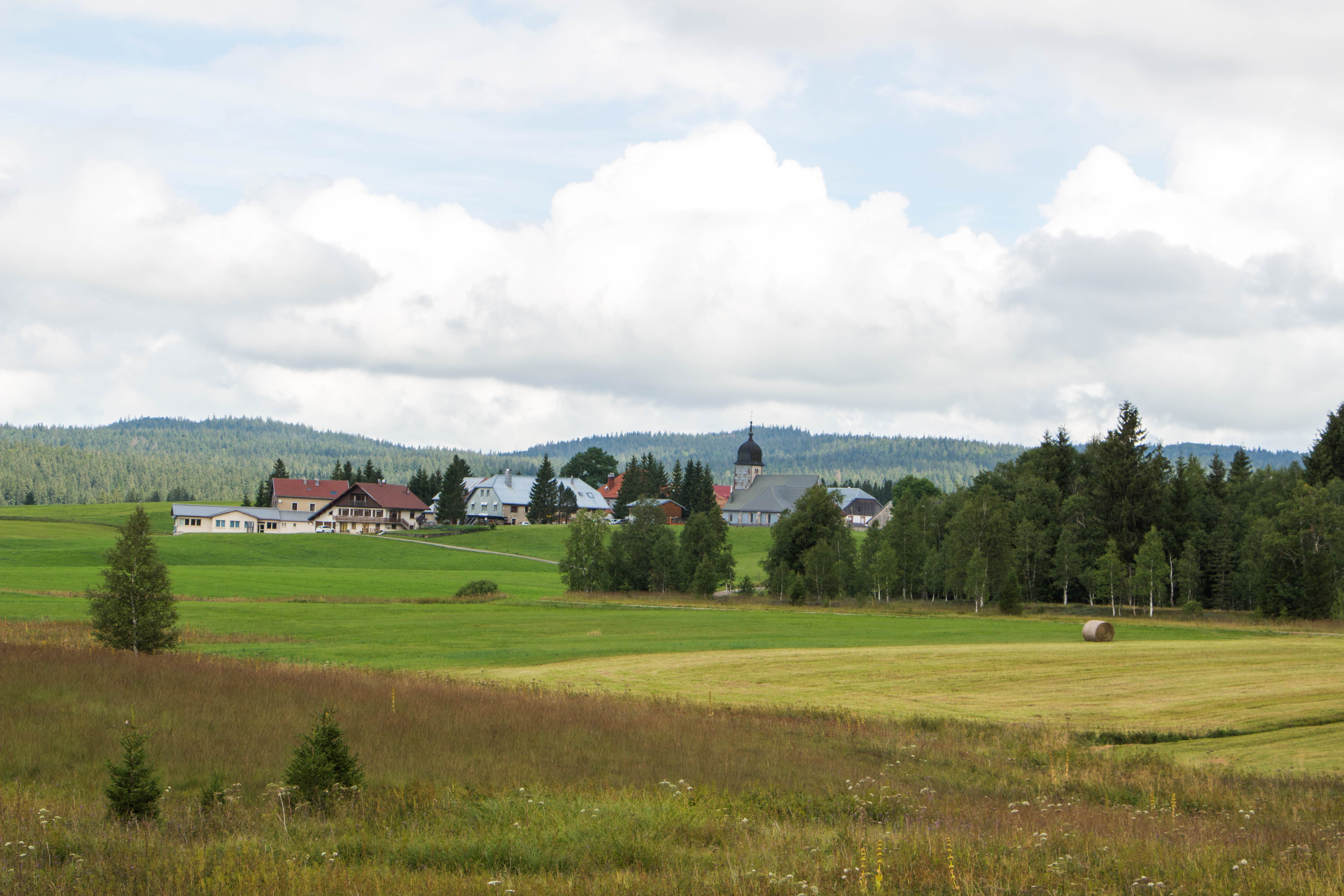
Chapelle-des-Bois trail
Opposite you, between the prairies and the cliffs, is a wooded area, that is earthy in places, with dark green spruces, white-trunked birches and light-leaved and slightly silver willows. In autumn, reds and yellows take over.
17 points of interest
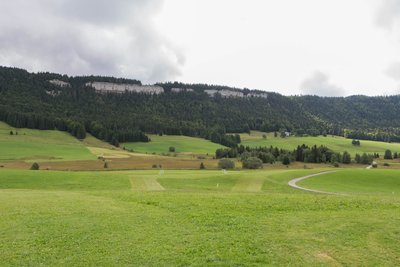
PNRHJ / Nina Verjus Natural environmentsFirst appearance of the landscape
100 to 200 million years ago, we would have travelled here by boat, on a tropical sea. Then limestone particles and shells slowly started to gather on the waterbed, gradually forming limestone layers.
During the Tertiary Period, these layers started to lift, fold and soon gave birth to the Jura Massif, with its relief comprised of folds and plateaux.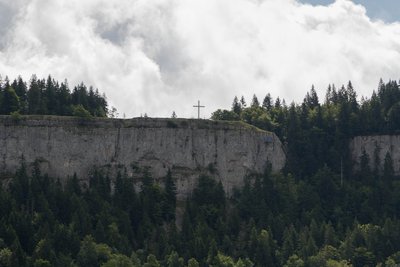
Roche Champion - PNRHJ / Nina Verjus History & HeritagePlaces full of history
Opposite you, the Roche Champion cliff marks the edge of the Risoux massif and separates Switzerland from France.
Before the 16th century, neither of these two countries wanted to claim the Jura, which was covered in forest. However, as the area was progressively cleared for agricultural purposes, competition for this land stepped up a notch. The Reform later exacerbated this rivalry, creating a political and religious rift between Switzerland and Protestants on one side and Franche-Comté and Catholics on the other. The Catholic cross that can be seen atop Roche Champion asserts this religious belonging.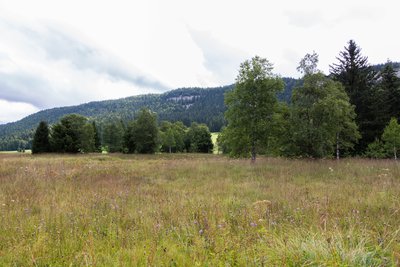
Tourbière - PNRHJ / Nina Verjus GeologyAppearance of the peat bog landscape
At the end of the Quaternary Period, the Jura was covered by a huge glacier. Reindeer and mammoths were abundant. This mass of ice changed the relief and broke and moved rocks. When it melted, the ice left glacier moraines in the watertight rocky holes left behind.
At the bottom of the depression, a lake later took shape, fed by the water from the melting glacier, from rainfall and from streams. Before long, the climate started to warm up. Aquatic plants quickly developed and organic matter accumulated. The lake filled and turned into a marsh.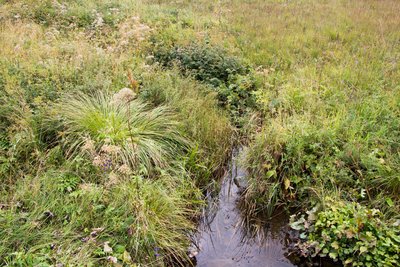
Ruisseaux qui serpentent dans la tourbière - PNRHJ / Nina Verjus Lakes & RiversStreams snaking through the peat bog
The stream you have crossed comes from the Cives combe. It is joined by another stream from the Risoux slopes (the mountain looming over you). After travelling underground, the stream surfaces near Morez, around ten kilometres from here. From there to here, it passes through the peat bog, with the latter acting like a sponge during rainy weather and when snow starts to melt. By doing so, the peat bog limits flooding, and then gradually returns the water during dry periods. Its last function is to purify the water running through it by acting as a filter.
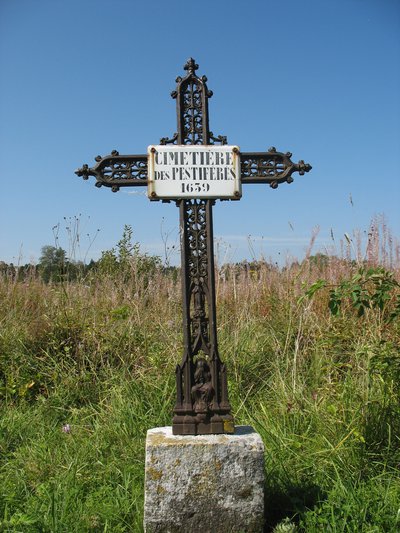
Cimetière des pestiférés - PNRHJ / Laurent Hilairet History & HeritageThe plague cemetery
In 1639, the plague wreaked havoc in the region. In Chapelle-des-Bois, it killed roughly fifteen of the 150 village inhabitants. Fearing that they might catch the illness, survivors did not want to bury the dead in the cemetery. Their decision to bury the plague-ridden corpses in the peat bog is no accident. Considered worthless land, and rarely used for agricultural purposes, the peat bog seemed the ideal place to bury victims of the plague without contaminating the land.
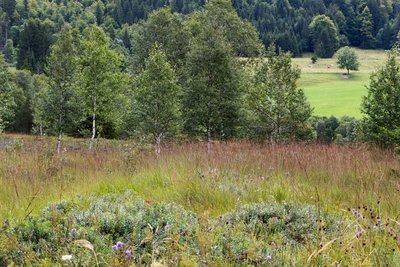
PNRHJ / Nina Verjus GeologyFormation of the peat bog
Sedges (or carex) grow and help stabilise the soil. Later, sphagnum peat moss takes over and forms a dense carpet. These are species of moss that grow continuously and that provide an accumulation of organic matter on which sphagnum peat moss is able to grow. The vegetation becomes compact and creates the black and fibrous bogs resembling garden compost. However, this phenomenon is painfully slow and it takes thousands of years for a peat bog to reach a height of just a few metres.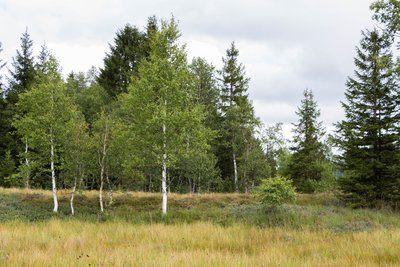
PNRHJ / Nina Verjus GeologyPeat bogs: history books
Peat bogs are valuable history books for pollen specialists or palynologists. In fact, pollen is well-preserved in peat bogs, and some pollen found there can even be thousands of years old!
From the oldest layers deeper down to the surface area, palynologists are able to retrace the history of plants in the peat bog and its surroundings all the way back to prehistoric times. Which trees used to grow in the forest? Which plants did man grow for food or for clothes? By analysing pollen, we can learn all of these things.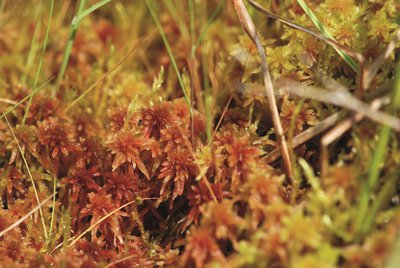
Sphaignes - Jocelyn Claude FloraPeat moss: a formidable type of moss
Peat moss acts like a sponge, absorbing up to 30 times its weight in water. It also creates an environment around it that is inhospitable to other plants that might compete with it.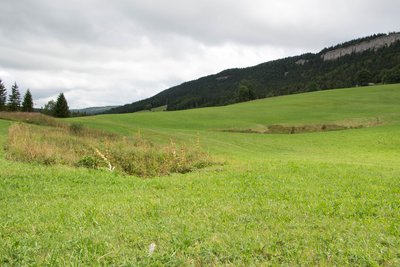
Dolines - PNRHJ / Nina Verjus GeologySinkholes
On both sides of the path, you will observe holes of several metres in diameter. These are sinkholes and they remind us that the Jura is a Karstic massif, resulting from the dissolution of limestone rocks by water, both on the surface and underneath. You may approach with care.
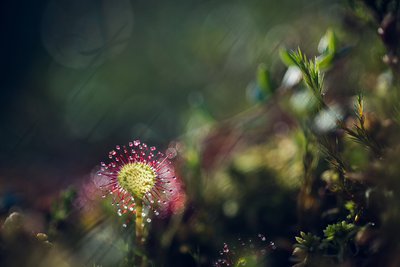
Droséra - PNRHJ / Léo Poudré FloraSundew reveals itself
Sundew, also known as Drosera, is another remarkable plant that can be found in the peat bog. This small carnivorous plant has the same “culinary” tastes as some birds (e.g. the meadow pipit) as it likes to feed on insects. It lives in the middle of peat bogs, around waterholes. Do not leave the path to avoid taking risks and damaging this peat bog which is very sensitive to the effects of treading and can dry out as it is compacted.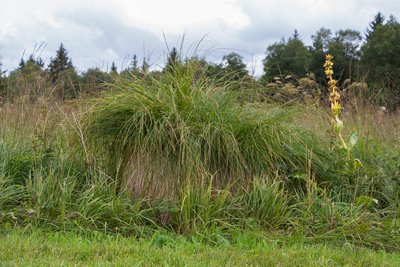
Touradon - PNRHJ / Nina Verjus FaunaTussocks and butterflies
In the summer, in the meadows around peat bogs, you will see a lot of pale pink spiky flowers. These are common bistort flowers and are home to a particular species of butterfly: the violet copper (dark blue-black and orange).
Many other insects such as the northern emerald (a dragonfly) and the cranberry fritillary (another butterfly) also live in the Chapelle-des-Bois peat bog.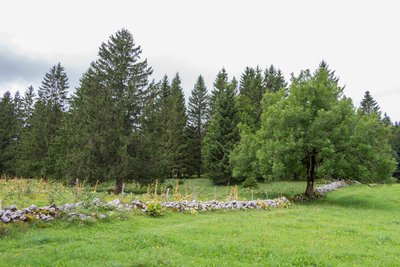
Pré-bois - PNRHJ / Nina Verjus Natural environmentsA meadow or a forest?
Do you think you are in a meadow or a forest? It’s not easy to tell: there are meadow-like clearings, but also large trees.
In fact, it’s a blend of the two, that inhabitants of the High-Jura merely call “wooded meadows”.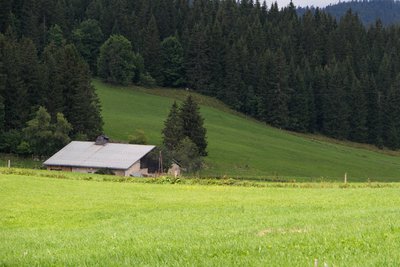
PNRHJ / Nina Verjus History & HeritageA dispersed-habitat landscape
You have now exited the wooded meadow and have come across vast stretches of wild land. Wild? Well, not really. If you look closely, Man has left his mark on this landscape.
Farms are scattered here and there and tell the story of how the High Doubs was “colonised’. In this area, where winters are long, home-based craftmanship, wood carving or clock-making developed to keep the peasants busy when the cold season forced them to stay inside.
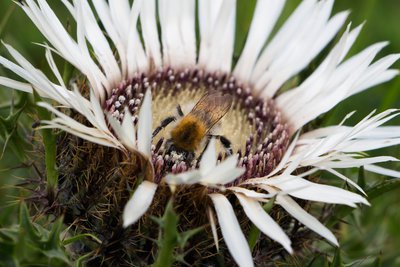
PNRHJ / Nina Verjus FloraA thousand colours in natural prairies
The vast landscapes you are in are natural prairies, in which biodiversity is particularly abundant and contributes towards the production of PDO (Protected Designation of Origin) cheeses. Farmers in Chapelle-des-Bois and the surroundings are particularly aware of this and ensure that the unicity of these landscapes is preserved by using suitable practices.
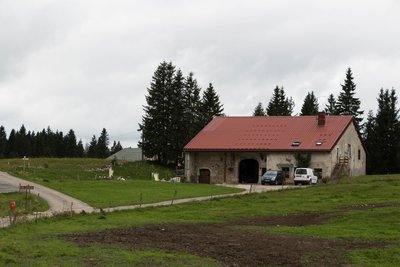
PNRHJ / Nina Verjus History & HeritageArchitecture of the High-Doubs
In the hamlet of “les Landry”, you will pass in front of a house that tells of some of the architectural history and construction techniques used in the High-Doubs. Years of “playing around” with wood, stone and metal.
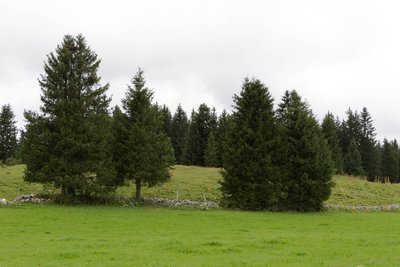
PNRHJ / Nina Verjus Pastoralism and agricultureFarming activities that leave their mark on the landscape
Agricultural buildings are scattered throughout this landscape: old farms are found alongside much larger modern agricultural buildings that house Montbeliarde cows. These cows produce the milk that is used to produce local cheeses.
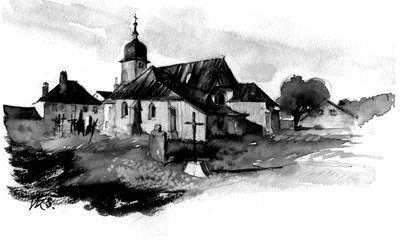
Eglise Saint-Jean-Baptiste - Véronique K. Simon architecte History & HeritageSaint-Jean-Baptiste Church
Works to build the church started in 1634. The massive appearance of this structure is amplified by the narrowness of its openings. It is covered with a metal shingle on its most-exposed outer walls. The church has been registered on the complementary inventory of Historical Monuments since 2 March 1981.
Description
From the hike starting point in CHAPELLE-DES-BOIS (Saint Jean-Baptiste church), the trail follows the D 46 towards the town hall (white and red waymarking) At “Chemin des Sources”, follow a road to the left that gradually heads downhill towards the bottom of the combe, bordered by hay fields.
At the lowest point of the combe, the road crosses a stream, where a cross has been erected. Continue on this road until you come to Bas du Risoux.
Leave the road and take the grassy path to your left (yellow waymarking) that slightly overlooks the peat bog’s east border.
The path gradually ascends to the hamlet Chez Michel.
The hike trail then heads to the right of the buildings, crosses the parking lot and enters the field, following along the low wall until it comes to the woods. Follow the path through the woods and exit into the la Chaumeau Pasture. Turn right, the path runs along the boundary and then crosses through a meadow, followed by an afforestation area, before coming to a road in Chaumelles.
Cross the road and continue along the path through the wooded meadow towards Les Champs Nouveaux.
Taking the road to your right (red and white waymarking), head past the houses in LES LANDRYS and return to the village.
- Departure : Chapelle-des-Bois town hall
- Arrival : Chapelle-des-Bois town hall
- Towns crossed : Chapelle-Des-Bois
Forecast
Sensitive areas
- Impacted practices:
- Aquatic,
- Sensitivity periods:
- JanFebMarAprMayJunJulAugSepOctNovDec
- Contact:
- Parc naturel régional du Haut-Jura
29 Le Village
39310 Lajoux
03 84 34 12 30
www.parc-haut-jura.fr/
Recommandations
This trail passes through pastures with livestock and forest paths. To respect the owners and farmers granting you passage, and for the security of livestock and wild fauna, we ask that you remain on the waymarked paths.
Use the adapted passageways to get across fencing and be sure to close gateways behind you.
Please keep your dog on a lead if you have one.
Wild flowers are beautiful, they may be rare and protected and often wilt quickly. Do not pick them! They will delight the next hikers.
In case of forest works (felling, skidding, etc.), for your safety, know when to stop and turn around.
Information desks
Tourist information centre - Val de Mouthe
3 bis rue de la Varée, 25240 Mouthe
Transport
To visit and get about in the High-Jura, visit www.reshaut-jura.fr, the eco-mobility portal listing all means of transport within the Park.
Access and parking
16 km east of Mouthe via the D 437 until you reach Chaux Neuve and then the D 46; 14 km from Morez via the N 5, followed by the D18 via Belloefontaine and then the D 46.
Parking :
Report a problem or an error
If you have found an error on this page or if you have noticed any problems during your hike, please report them to us here:
